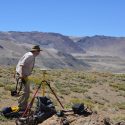Lava flows reveal clues to magnetic field reversals
Ancient lava flows are guiding a better understanding of what generates and controls the Earth’s magnetic field — and what may drive it to occasionally reverse direction.
The main magnetic field, generated by turbulent currents within the deep mass of molten iron of the Earth’s outer core, periodically flips its direction, such that a compass needle would point south rather than north. Such polarity reversals have occurred hundreds of times at irregular intervals throughout the planet’s history — most recently about 780,000 years ago — but scientists are still trying to understand how and why.
A new study of ancient volcanic rocks, reported in the Sept. 26 issue of the journal Science, shows that a second magnetic field source may help determine how and whether the main field reverses direction. This second field, which may originate in the shallow core just below the rocky mantle layer of the Earth, becomes important when the main north-south field weakens, as it does prior to reversing, says Brad Singer, a geology professor at the University of Wisconsin–Madison.
Singer teamed up with paleomagnetist Kenneth Hoffman, who has been researching field reversals for over 30 years, to analyze ancient lava flows from Tahiti and western Germany in order to study past patterns of the Earth’s magnetic field. The magnetism of iron-rich minerals in molten lava orients along the prevailing field, then becomes locked into place as the lava cools and hardens.
“When the lava flows erupt and cool in the Earth’s magnetic field, they acquire a memory of the magnetic field at that time,” says Singer. “It’s very difficult to destroy that in a lava flow once it’s formed. You then have a recording of what the paleofield direction was like on Earth.”
Hoffman, of both California Polytechnic State University at San Luis Obispo and UW–Madison, and Singer are focusing on rocks that contain evidence of times that the main north-south field has weakened, which is one sign that the polarity may flip direction. By carefully determining the ages of these lava flows, they have mapped out the shallow core field during multiple “reversal attempts” when the main field has weakened during the past million years.
During those periods of time, weakening of the main field reveals “virtual poles,” regions of strong magnetism within the shallow core field. For example, Singer says, “If you were on Tahiti when those eruptions were taking place, your compass needle would point to not the North Pole, not the South Pole, but Australia.”
The scientists believe the shallow core field may play a role in determining whether the main field polarity flips while weakened or whether it recovers its strength without reversing. “Mapping this field during transitional states may hold the key to understanding what happens in Earth’s core when the field weakens to a point where it can actually reverse,” Hoffman says.
Current evidence suggests we are now approaching one of these transitional states because the main magnetic field is relatively weak and rapidly decreasing, he says. While the last polarity reversal occurred several hundred thousand years ago, the next might come within only a few thousand years.
“Right now, historic records show that the strength of the magnetic field is declining very rapidly. From a quick back-of-the-envelope prediction, in 1,500 years the field will be as weak as it’s ever been and we could go into a state of polarity reversal,” says Singer. “One broad goal of our research is to provide some predictive capability for what could happen and what could be the signs of the next reversal.”
Hoffman and Singer’s research has been supported largely by grants from the National Science Foundation.


